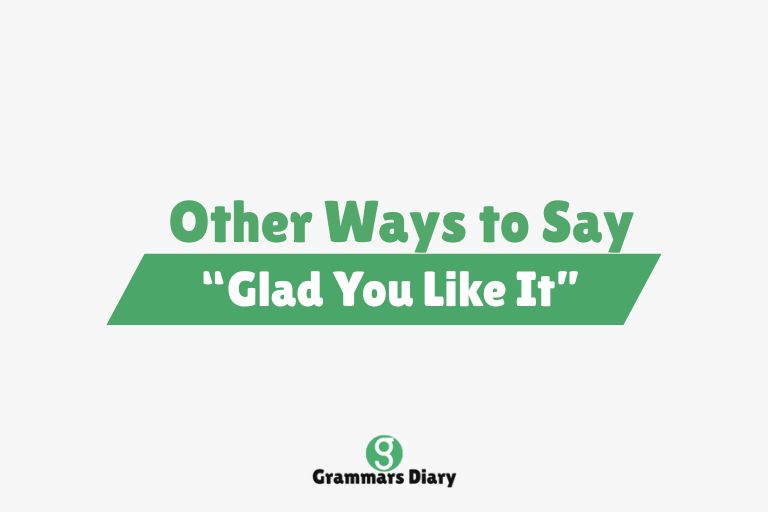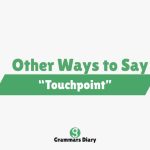“Glad you like it” is a friendly and common phrase used to express happiness or satisfaction when someone appreciates something you’ve said, done, or given. For example, when a friend compliments your cooking or praises your design, saying “Glad you like it” lets them know you’re pleased with their positive reaction.
However, repeating this phrase in every interaction can feel repetitive, especially in social, professional, or creative settings. Fortunately, there are many alternative ways to express this same sentiment—each carrying its own tone, warmth, and nuance. Whether you’re responding in an email, over text, or in person, using a varied vocabulary adds a more personalized touch to your replies.
This article explores 20 versatile alternatives to “Glad you like it,” with examples, meanings, and guidance on when to use each one.
Other Ways to Say “Glad You Like It”
1. I’m happy to hear that
Example: “I’m happy to hear that the presentation resonated with you.”
Meaning: A warm and genuine way to show that someone’s positive reaction made you feel good.
Usage: Appropriate in both personal and professional settings where sincerity is key.
2. That means a lot to me
Example: “That means a lot to me—thank you for saying that.”
Meaning: Shows emotional appreciation and conveys that their words have touched you deeply.
Usage: Best used when the compliment feels especially meaningful or heartfelt.
3. I’m thrilled you enjoyed it
Example: “I’m thrilled you enjoyed it—it took a lot of effort to put together.”
Meaning: Expresses enthusiasm and excitement about someone’s enjoyment.
Usage: Great for passionate responses, especially in creative or performance-based situations.
4. I appreciate your kind words
Example: “I appreciate your kind words about the project.”
Meaning: A polite and professional way to acknowledge praise.
Usage: Ideal in formal conversations or written replies, such as emails or messages at work.
5. So glad it made a difference
Example: “So glad it made a difference for you—thanks for letting me know.”
Meaning: Highlights that your effort had a meaningful or helpful impact.
Usage: Works well when responding to appreciation for support, advice, or thoughtful action.
6. That’s wonderful to hear
Example: “That’s wonderful to hear—I hoped it would turn out well.”
Meaning: Expresses satisfaction and delight upon hearing something positive.
Usage: Suitable in a wide range of friendly or professional settings.
7. I’m really pleased you liked it
Example: “I’m really pleased you liked it—it was a fun project to work on.”
Meaning: A slightly more formal and measured way to express happiness about someone’s approval.
Usage: Works well in both casual and formal situations, especially in professional feedback.
8. That makes me really happy
Example: “That makes me really happy—thank you for the feedback.”
Meaning: Directly shares your emotional response to someone’s appreciation.
Usage: Often used in heartfelt or close personal interactions.
9. I’m glad it resonated with you
Example: “I’m glad it resonated with you—it came from a very personal place.”
Meaning: Indicates that someone emotionally or intellectually connected with your message or effort.
Usage: Best for creative, educational, or thought-provoking contexts.
10. I’m so glad you said that
Example: “I’m so glad you said that—I wasn’t sure how it would be received.”
Meaning: Emphasizes relief or reassurance after receiving a positive response.
Usage: Great for moments of vulnerability or when you’re unsure how your efforts might be received.
11. I’m grateful you think so
Example: “I’m grateful you think so—it really motivates me to keep going.”
Meaning: A polite and thankful way of expressing appreciation for someone’s opinion.
Usage: Well-suited for personal acknowledgments or when you want to convey humility and gratitude.
12. I’m flattered you liked it
Example: “I’m flattered you liked it—your opinion means a lot to me.”
Meaning: Shows that you feel honored by their compliment, often used modestly.
Usage: Good in both formal and informal contexts, particularly when the compliment comes from someone respected.
13. It’s great to know that
Example: “It’s great to know that you enjoyed the workshop.”
Meaning: A simple yet positive acknowledgment that shows you’re pleased with their feedback.
Usage: Versatile and appropriate in emails, texts, or spoken replies.
14. That’s music to my ears
Example: “That’s music to my ears—I hoped it would make an impact.”
Meaning: A playful and cheerful way of saying you’re very happy to hear something.
Usage: Best used in casual or light-hearted situations.
15. I’m delighted you’re enjoying it
Example: “I’m delighted you’re enjoying it—I wanted it to be special.”
Meaning: A formal but warm way to express deep satisfaction with someone’s appreciation.
Usage: Suitable for creative, customer service, or hospitality contexts.
16. I’m overjoyed that you liked it
Example: “I’m overjoyed that you liked it—it’s one of my favorite projects.”
Meaning: Emphasizes intense happiness and emotional response.
Usage: Best when you want to show strong enthusiasm or emotional involvement.
17. It makes me so happy to hear that
Example: “It makes me so happy to hear that—it truly means a lot.”
Meaning: Expresses genuine emotional satisfaction in response to praise.
Usage: Effective in warm, personal conversations.
18. I worked hard on it, so that means a lot
Example: “I worked hard on it, so that means a lot to hear.”
Meaning: Acknowledges the effort involved and shows that the feedback is truly appreciated.
Usage: Ideal when your work or time investment was significant.
19. That kind of feedback really keeps me going
Example: “That kind of feedback really keeps me going—thank you so much.”
Meaning: Expresses that the praise provides encouragement or motivation.
Usage: Appropriate for writers, artists, or professionals who rely on feedback to continue their work.
20. Thanks! That really made my day
Example: “Thanks! That really made my day—it means more than you know.”
Meaning: A casual and upbeat way of saying the compliment had a strong emotional impact.
Usage: Friendly and informal, often used in texts, comments, or casual chats.
When to Use Different “Glad You Like It” Alternatives
In Casual Conversations
In informal settings such as talking with friends, texting, or chatting online, phrases like “Thanks! That really made my day,” “That’s music to my ears,” or “I’m happy to hear that” add variety while keeping the tone light and friendly. These alternatives help express genuine warmth without sounding repetitive.
In Professional Settings
When responding to feedback in the workplace, on LinkedIn, or via business emails, it’s best to use more polished phrases like “I appreciate your kind words,” “I’m grateful you think so,” or “It’s great to know that.” These options sound respectful and confident while still expressing gratitude.
In Creative or Artistic Contexts
If someone compliments your art, writing, performance, or product, showing emotional connection can enhance the exchange. Phrases such as “I’m thrilled you enjoyed it,” “I’m glad it resonated with you,” or “That kind of feedback really keeps me going” communicate appreciation while acknowledging your creative effort.
Conclusion
While “Glad you like it” is a perfectly fine and friendly way to respond to praise or compliments, it doesn’t have to be your only go-to phrase. By using these 20 thoughtful and expressive alternatives, you can tailor your responses to the tone of the conversation, the relationship you have with the speaker, and the setting you’re in—whether casual, professional, or artistic.
Experimenting with these phrases not only helps you sound more genuine and emotionally aware, but it also improves the quality of your conversations by making your reactions feel more intentional and sincere.
FAQs
What does “Glad you like it” mean?
It’s a friendly way to show that someone’s enjoyment or approval makes you feel pleased or satisfied.
Is “Glad you like it” informal?
Yes, it tends to be more casual. In formal settings, consider alternatives like “I appreciate your feedback” or “I’m pleased to hear that.”
Can I use these alternatives in emails or messages?
Absolutely. Many of these expressions work well in written communication—especially when you want to show professionalism or warmth.
Which phrases are best for customer service?
Phrases like “I’m delighted you’re enjoying it,” “That’s wonderful to hear,” or “Thanks! That really made my day” strike a nice balance between friendly and professional.











